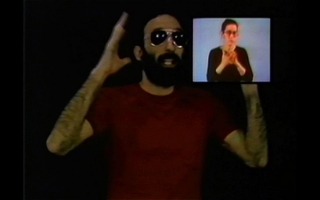Date: 3 June 2005 | Season: The Write Stuff
PATTERNS OF SPEECH
Friday 3 June 2005, at 7pm
London Corsica Studios
Four videotapes which each explore variations in spoken language. “Mesostics” are poems in which a string of vertical letters, one from each line, spells a name or word. John Cage’s calm and sage delivery of these phrases sits in stark contrast with the deranged performance by actor Tim Thompson, in Paria, which is based on workshops condicted with prisoners at a correctional facility. Taped by video pioneers the Vasulka’s, these disturbing monologues are further unhinged by their technological distortion of the image. The second half of the programme features tapes by Peter Rose, who has conducted a deep investigation of language and text throughout his work, whilst demonstrating an incisive sense of humour. He often uses invented words, subtitles, sign language and direct address to spin yarns that examine syntax and patterns of speech, while simultaneous exploring the nature of film and video media itself. This is a rare screening of two seminal videotapes that are practically unknown in the UK.
John Cage/Soho TV, 36 Mesostics Re. and not Re. Duchamp, USA, 1978, videotape, 26 min
Woody & Steina Vasulka, Pariah, USA, 1984, videotape, 26 min
Peter Rose, The Pressures of the Text, USA, 1983, videotape, 17 min
Peter Rose, Digital Speech, USA, 1984, videotape, 13 min
Curated by Mark Webber for The Write Stuff Literary Festival at Corsica Studios.
PROGRAMME NOTES
PATTERNS OF SPEECH
Friday 3 June 2005, at 7pm
London Corsica Studios
36 MESOSTICS RE. AND NOT RE. DUCHAMP
John Cage / Soho TV, USA, 1978, videotape, 26 min
“Like acrostics, mesotics are written in the conventional way horizontally, but at the same time they follow a vertical rule, down the middle not down the edge as in an acrostic, a string spells a word or name, not necessarily connected with what is being written, though it may be. This vertical rule is lettristic and in my practice the letters are capitalized. Between two capitals in a perfect or 100% mesostic neither letter may appear in lower case. …. In the writing of the wing words, the horizontal text, the letters of the vertical string help me out of sentimentality. I have something to do, a puzzle to solve. This way of responding makes me feel in this respect one with the Japanese people, who formerly, I once learned, turned their letter writing into the writing of poems. In taking the next step in my work, the exploration of nonintention, I don’t solve the puzzle that the mesostic string presents. Instead I write or find a source text which is then used as an oracle. I ask it what word shall I use for this letter and what one for the next, etc. This frees me from memory, taste, likes, and dislikes. Words come first from here and then from there. The situation is not linear. It is as though I am in a forest hunting for ideas.” (John Cage)
PARIAH
Woody & Steina Vasulka, USA, 1984, videotape, 26 min
In 1983 Tim Thompson was an artist in residence at the Las Lunas correctional facilities, New Mexico, conducting a theatre workshop. While working with the inmates, he became familiar with theirs life stories, their vocabulary and their physical demeanour. This became the source material for a composite character, later portrayed in his one-man theater production Pariah in Santa Fe. This turned out to be his last production and performance. Tim Thompson, one of the most brilliant performers we ever met has turned full time to the digital arts in both moving and still images. The performance was taped in Eve Muir’s studio in Santa Fe in May of 1984, and edited later with the addition of the Rutt/Etra scan-processing effects. The work as a whole is seldom seen, however segments of Pariah have become a part of Steinas MIDI Violin repertoire. (Vasulkas)
THE PRESSURES OF THE TEXT
Peter Rose, USA, 1983, videotape, 17 min
The Pressures of the Text integrates direct address, invented languages, ideographic subtitles, sign language and simultaneous translation to investigate the feel and form of sense, the shifting boundaries between meaning and meaninglessness. A parody of art/critic-speak, educational instruction, gothic narrative, and pornography, it has been performed as a live work at major media centres and new music festivals in the US and Europe. The piece was written, directed and delivered by Peter Rose; co-directed by Jessie Lewis; with sign language and ideographic symbols by Jessie Lewis; and with English simul-translation by Fred Curchack. (Peter Rose)
DIGITAL SPEECH
Peter Rose, USA, 1984, videotape, 13 min
Digital Speech uses a traveller’s anecdote, a perverse variant of a classic Zen parable, as a vehicle for an exploration of language, thought and gesture. The tape plays with the nature of narrative, with ways of telling, performing and illustrating, and uses nonsense language, scat singing and video rescan for comic comment. (Peter Rose)
Back to top
